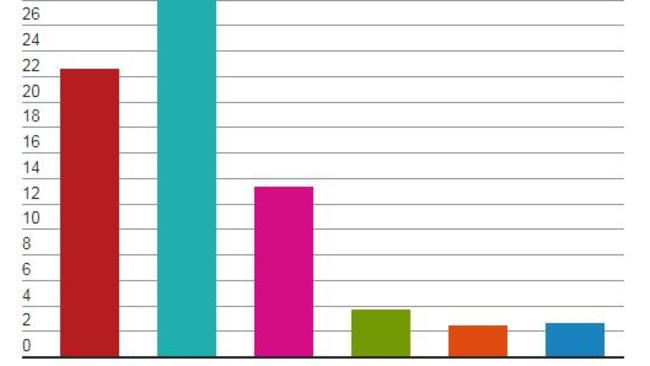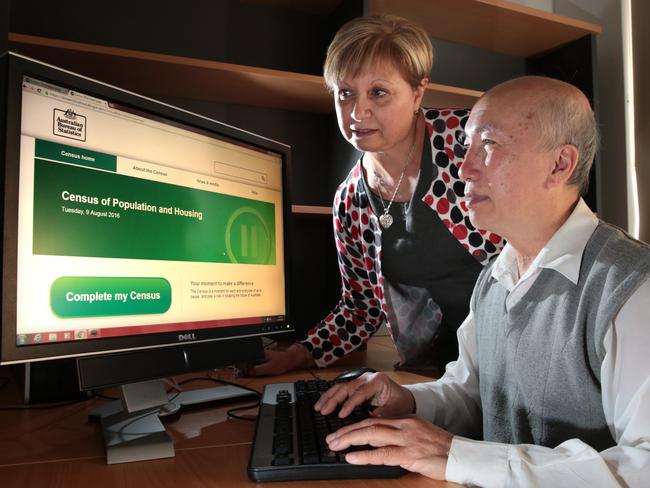‘No religion’ tops religion question in Census
THE results of the Census are in and there are some surprising facts, including what Australians believe about religion.

DESPITE a scare campaign about Australia becoming a “Muslim country”, those ticking “no religion” in the Census has now overtaken the number of Catholics.
It’s the first time in Australia’s history the number of people who claim “no religion” has overtaken Catholics.
The latest Census drop showed those ticking “no religion” rose from 22.6 per cent to 29.6 per cent — nearly double the 16 per cent in 2001.
Meanwhile, those identifying as Catholic dropped from 25.3 per cent to 22.6 per cent.
The number of Christians in total still made up 51 per cent of the population, but this is much less than the 88 per cent in 1966 and 74 per cent in 1991.
Islam (2.6 per cent) and Buddhism (2.4 per cent) were the next most common religions reported.
Islam grew from 2.2 per cent in 2011, overtaking Buddhism, which dropped from 2.5 per cent, to become the most popular non-Christian religion.
The religion question was controversial this year, with Australians warned not to mark “no religion” on the Census survey by those afraid the nation would become a “Muslim country”.
An email was circulated that asked Australians to avoid the “no religion” option as this would give prominence to Muslims.
Those reporting no religion increased noticeably from 19 per cent in 2006 to 30 per cent in 2016. The largest change was between 2011 (22 per cent) and 2016, when an additional 2.2 million people reported having no religion.
But it was Hinduism that had the most significant growth between 2006 and 2016, driven by immigration from South Asia.
Those who did not answer the religion question, which is a non-compulsory question in the Census, was 9.6 per cent, up slightly from 9.2 per cent in 2011.
The results show Australia remains a predominantly religious country, with 60 per cent of people reporting a religious affiliation but the trend towards “no religion” has some calling for changes.
The Atheist Foundation of Australia said it was time to stop pandering to religious minorities and to take religion out of politics.
AFA president Kylie Sturgess said political, business and cultural leaders needed to listen to the non-religious when it came to public policy that’s based on evidence, not religious beliefs.
“This includes policy on abortion, marriage equality, voluntary euthanasia, religious education in state schools and anything else where religious beliefs hold undue influence,” she said.
She said certain religious groups seemed to get automatic consideration in the public policy sphere and to enjoy a privileged position that wasn’t afforded to other large groups, such as the non-religious.
“That has to stop. Politicians, business leaders and influencers take heed: this is an important milestone in Australia’s history. Those who marked down ‘No religion’ deserve much more recognition. We will be making our opinions known, and there’s power in numbers.”
How likely a person was to identify as religious in 2016 had a lot to do with their age.
Young adults aged 18-34 were more likely to be affiliated with religions other than Christianity (12 per cent) and to report not having a religion (39 per cent) than other adult age groups.
Older age groups, particularly those aged 65 years and over, were more likely to report Christianity.
In terms of states, New South Wales had the highest religious affiliation (66 per cent of people reporting a religious affiliation), while Tasmania (53 per cent) was the lowest.
An earlier release of Census data in April showed the typical Australian was now a 38-year-old married woman with two children.
MAJOR FINDINGS OF THE 2016 CENSUS
• Australia’s estimated population at December 31 was 24.4 million people.
• There were 23,717,421 people in Australia on Census night, which included 23,401,892 people who usually live in Australia — an 8.8 per cent increase from 2011. More than 600,000 Australians were travelling overseas.
• NSW remains our most populous state, with 7,480,228 people counted, ahead of Victoria (5,926,624) and Queensland (4,703,193).
• The Australian Capital Territory experienced the largest population growth of any state or territory over the past five years, adding more than 40,000 new residents - an increase of 11 per cent.
• Greater Sydney is Australia’s largest population centre with 4,823,991 people, growing at 1656 every week since the previous Census.
• 1.3 million new migrants have come to Australia since 2011, hailing from some of the 180 countries of birth recorded in the Census, with China (191,000) and India (163,000) being the most common countries of birth of new arrivals.
• Of all Australian residents, just more than a quarter of people (26 per cent) said they were born overseas, with England remaining the most common country of birth other than Australia. For the first time in our history, the majority of people born overseas are now from Asia, not Europe.
RELATED: Census provides snapshot of Australia

• We remain a predominantly an English speaking country, with 72.7 per cent of people reporting they speak only English at home. Tasmania had the highest rate of people speaking only English at home with 88 per cent, while the Northern Territory had the lowest rate at 58 per cent.
• Australians are getting older with 664,473 additional people aged 65 and over since 2011.
CONTROVERSY
The full version of the census results were publicly released on Tuesday.
The Australian Bureau of Statistics took the census online for the first time last August, to survey Australia’s 24 million population.
The exercise was marred by cyber attacks which prompted the bureau to shut it down for almost two days.
It also resulted in IT company IBM paying out millions of dollars in compensation for its role in the mess.
The Independent Assurance Panel, established by the Australian Statistician to provide extra assurance and transparency of Census data quality, concluded that the 2016 Census data could be used with confidence.
“The 2016 Census had a response rate of 95.1 per cent and a net undercount of 1.0 per cent, meaning the quality is comparable to both previous Australian censuses and censuses in other countries, such as New Zealand, Canada, and the United Kingdom,” Australian Statistician David W. Kalisch.
A Senate inquiry conducted last year concluded the main responsibility for this bungled event lay with the federal government, because of reduced funding for the bureau when demands put on it had increased.
The census questions each household on age, gender, incomes, occupations, dwellings, transportation, ancestry, languages spoken, and religion, to help with future planning for the nation.



